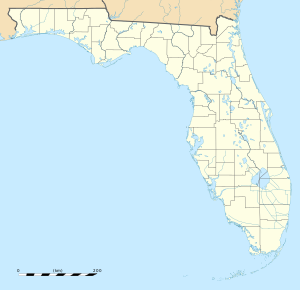Page Field Army Airfield
| Page Field Army Airfield | |
|---|---|
| Part of Third Air Force | |
| Fort Myers, Florida | |

Page Field Army Airfield - 1944
|
|
| Coordinates | 26°35′12″N 081°51′48″W / 26.58667°N 81.86333°WCoordinates: 26°35′12″N 081°51′48″W / 26.58667°N 81.86333°W |
| Site history | |
| Built | 1927 |
| Built by | United States Air Force |
| In use | 1942-1946 |
| Battles/wars | World War II |
Page Field Army Airfield is an inactive United States Army Air Forces base, approximately 4 miles south of Fort Myers, Florida. It was active during World War II as a Third Air Force training airfield. It was closed on 30 September 1945, two years prior to the establishment of the United States Air Force as an independent service.
In 1924, the city of Fort Myers, Florida, purchased 670 acres of land south of the city with the intention of developing it into a municipal golf course. However, that plan was halted when a Florida "Land Bust" stopped development.
In 1927, it became a civil airport named "Palmetto Field", for the large amount of palmetto brush growing in and around the airport.National Airlines commenced regular flights into the airfield in 1937, but those were soon discontinued due to the poor landing conditions. Efforts to upgrade the airfield were boosted by a January 1940 Works Projects Administration (WPA) project constructed three concrete runways. In addition, other improvements were made and by the time of the Pearl Harbor Attack, "Lee County Airport" had grown to about 600 acres in size.
With the United States at war, the War Department decided to lease the airport from Lee County, and the initial lease for its military use was signed in February 1942, and later renewed in June 1944. The airport was turned over to the jurisdiction of the United States Army Air Forces, who assigned it to Third Air Force. At first, the USAAF called the airport Fort Myers Army Air Base; eventually the field would be named Page Field Army Airfield to honor Captain Richard Page, a World War I aviator killed in a seaplane accident near Everglades, Florida on March 3, 1920. Captain Page was the first person from Florida to join the Aviation Section, U.S. Signal Corps. During World War I, he was credited with three German aircraft destroyed in combat and was the recipient of the Distinguished Service Cross along with the French Croix de Guerre and other awards.
...
Wikipedia


